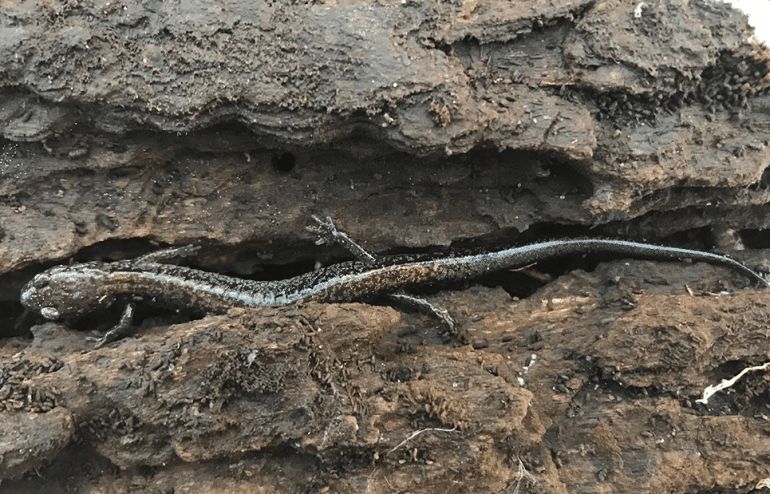A Worm Lizard
More times than not, when I lift a log with a group of kids, I hear, “A worm!” The next guess is usually, “No, it’s a lizard!” In their defense, salamanders are slimy, with four disproportionately small legs attached to a long, slender body. They even cohabitate in leaf litter or under rocks and logs, though the worms better be careful because they (and many other invertebrates) are part of a salamander’s diet. They’re actually amphibians, and unlike lizards and reptiles, salamanders lack claws, external ear holes, and scales. Eastern red-backed salamanders (Plethodon cinereus) are one of the most common salamander species found in Eastern North America. They can be found in two morphs: red-back (pic 1) has a bright reddish stripe down its back; while lead-back (pic 2) lack the stripe and are mostly grayish-black. All color variations have the mottled black and white belly.
Red-backs belong to the family Plethodontidae, also known as the lungless salamanders. Thus, like their amphibian relatives, they breathe through their skin. These sals possess a nasolabial groove, a slit between their nostril and upper lip. It helps with chemical cues involved with courtship, territory, and food. These unique woodland salamanders lack the common aquatic larval stage and lay their eggs in small clusters in cavities under rocks and logs in early summer. It’s a shame they skip this stage because gilled salamander larvae are adorable, but I suppose it’s a pretty nifty adaptation that has evolved in this group. The larvae develop in the egg (gills and all) and hatch in late summer.
Have you ever seen a reddish-brown, slimy creature wriggling frantically? No head, no eyes, no legs…not segmented like a worm…furiously flipping back and forth? A salamander can drop its tail in a last attempt to save itself from being eaten. The tail distracts predators while the rest of the salamander dives out of sight into the safety of shelter. When I encountered this ‘flee of survival’, a child was the curious “predator” trying to pick it up. We must be careful while handling our skin-breathing amphibian friends and also remember that humans often have harmful substances on our hands such as sunscreen, soap residue, or lotion. The red-backs are in full force right now because the warm spring weather is allowing them to emerge from their winter underground hideouts. I encourage you to take a hike and carefully lift a log or large piece of bark to find some of these little sals. Just remember to put the roof back on their home!
~Tracy

